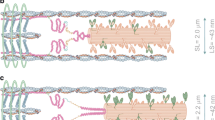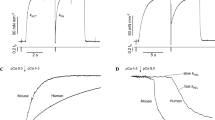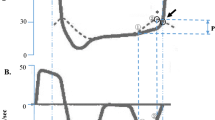Summary
The central hypothesis of this investigation is that a shortening myocyte generates a time-varying transmural pressure, or intracellular pressure. A mathematical model was formulated for a single myocyte, consisting of a fluid-filled cylindrical shell with axially arranged contractile filaments, to quantitate the fiberfluid interaction. In this model, the intracellular pressure mediates the interaction between myofilament force, cell shortening, and the mechanical properties of the sarcolemma. Shortening of myofibrils, which are embedded in the fluid-filled myocytes, deforms the myocyte, thereby altering its transmural fluid pressure. This increase in transmural pressure counteracts fiber shortening, hence constituting an internal load to shortening. The shortening of the myocyte is accompanied by thickening, due to the incompressible nature of its contents. Consequently, the overall contractile performance of the cell is integrally linked to the generation of intracellular pressure. The model manifests a positive transmural pressure during shortening, but not without shortening. The pressure in the myocyte, therefore, is not a direct function of the force generated, but rather of shortening. Intracellular pressure was measured through a fluid-filled glass micropipette (5 µ ID) employing a servo-nulling pressure transducer in a standard micropuncture technique. Measured intracellular pressure in a contracting isolated skeletal myocyte of the giant barnacle is observed to be dynamically related to shortening, but not to tension without shortening. The relation between the force of contraction, cell shortening, and intracellular pressure was assessed during both isotonic and isometric contractions. The results support the prediction that isometric, or nondeforming, contractions will not develop intracellular pressure and identify a reason for relengthening of the myocytes during relaxation.
Similar content being viewed by others
References
Rabbany SY, Kresh JY, Noordergraaf A (1989) Intramyocardial pressure: interaction of myocardial fluid pressure and fiber stress. Am J Physiol 257:H357-H364
Rabbany SY (1991) The genesis of intramyocardial pressure. Ph.D. dissertation, University of Pennsylvania, Philadelphia. Available from University Microfilms, Ann Arbor, MI
Streeter DD Jr, Spotnitz HM, Patel DP, Ross J Jr, Sonnenblick EH (1969) Fiber orientation in the canine left ventricle during diastole and systole. Circ Res 24:339–347
Streeter DD Jr, Powers WE, Ross MA, Torrent-Guasp F (1978) Three dimensional fiber orientation in the mammalian left ventricular wall. In: Baan J, Noordergraaf A, Raines J (eds) Cardiovascular system dynamics. MIT Press, Cambridge, p 73–84
Guasp FT (1987) Estructure y mechanica del corazon. Grass Endiciones, Barcelona, p 78
Hoyle G, Smyth T Jr (1963) Neuromuscular physiology of giant muscle fibers of a barnacle,Balanus nubilus Darwin. Biochem Physiol 10:291–314
Fox JR, Wiederhielm CA (1973) Characteristics of the servo-controlled micropipette pressure system. Microvasc Res 5:324–335
Author information
Authors and Affiliations
Additional information
This paper won a prize in the Sagawa Young Investigators' Awards competition at the 10th International Conference of the Cardiovascular System Dynamics Society in Kobe, September 24, 1992.
Rights and permissions
About this article
Cite this article
Rabbany, S.Y., Funai, J.T. & Noordergraaf, A. Pressure generation in a contracting myocyte. Heart Vessels 9, 169–174 (1994). https://doi.org/10.1007/BF01746060
Received:
Revised:
Accepted:
Issue Date:
DOI: https://doi.org/10.1007/BF01746060




